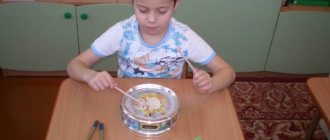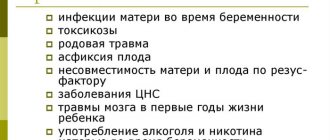Phonemic awareness is the ability of a person to distinguish, analyze and differentiate the syllables and sounds of human speech.
Phonemic hearing disorder (PHD) is not an ENT disorder. With defects in phonemic hearing, physiological hearing is usually well developed. A child may even have an ear for music. The problem is that it doesn't recognize phonemes—individual sounds—well. For example, instead of the word “porridge” he says “Kafka”, instead of “spoon” he says “loska”, etc.
With such a deviation, acoustic dysgraphia appears in children of school age. Because of this, difficulties arise with learning and correctly reproducing heard words. Spelling and learning new languages are especially difficult. But it will be difficult to succeed in other subjects - the ability to write and speak correctly will be useful everywhere. Failure in studies negatively affects a child’s self-esteem; he gets used to feeling like an outsider, and this is fixed in his subconscious. That is why it is very important to correct this deficiency before school or, if this does not happen, in primary school.
Development of phonemic hearing
Phonemic hearing begins to develop from birth. The baby first learns to distinguish everyday sounds: the sound of a hammer, the sound of water from a tap, the click of a switch. But this is not yet phonemic hearing, but its prerequisites are the discrimination of everyday object noises. The temporal cortex of the right hemisphere is responsible for this function, as well as for musical hearing, the hearing of animals and birds.
The further development of auditory perception can be divided into the following stages:
- A child aged 1-2 months begins not only to respond to environmental sounds, but also tries to repeat them (humming).
- Gradually distinguishes various intonations, practices in reproducing vowel sounds and their combinations.
- Then he learns to distinguish the rhythmic pattern of a word. Already repeats sounds and straight open syllables after adults.
- By about 8 months, the baby uses only those sounds that are present in his native speech (babble).
- At 1-2 years of age, proof of the correct development of phonemic hearing will be the child’s understanding of the speech with which adults address him. He is able to carry out simple instructions, such as: “bring the doll”, “sit on the typewriter”. It also gives adequate answers to basic questions: “where is mom?”, “Are you thirsty?”
- At normal rates of intellectual development, by the age of 3, a child’s phonemic hearing is practically formed; he is able to recognize incorrect pronunciation and distinguish native from foreign speech. Also, at the age of 3-4 years, the child should have back-lingual sounds (H-K-G). If a child pronounces them incorrectly (“kh” instead of “k”) or replaces one sound with another (“D” instead of “G”), then the reason may also be a violation of phonemic hearing.
- At 4-5 years old, a child without deviations well masters the technique of pronunciation of most sounds (except for hissing-whistles and R-L, which normally should appear before the age of 6-7 years). If this does not happen, then there is a violation of phonemic hearing, which must be eliminated in order to avoid problems with pronunciation and learning in the future.
In the process of forming speech hearing and developing speech in a child, the temporal zone of the right hemisphere first develops, and then (at about 1.5 years) the left hemisphere begins to specialize in speech. Accordingly, the temporal cortex of the right hemisphere remains “responsible” for rhythms, music and object noise, and phonemic hearing is “settled” in the temporal cortex of the right hemisphere. Thus, with a severe variant of impaired understanding of addressed speech (speech auditory agnosia), a child can understand intonations, respond to music, even use realistic onomatopoeia of animals, but at the same time not understand human speech.
How to develop phonemic hearing in children with ODD. Consultations for parents.
GBDOU d/s No. 15 of a compensating type in the Petrogradsky district of St. Petersburg. Speech therapist teacher: Kuzmenko L.N.
Phonemic hearing is a person’s ability to analyze and synthesize speech sounds, i.e. hearing, which provides the perception of phonemes of a given language. "Speech therapist's dictionary" ed. IN AND. Seliverstova.
Most parents believe that it is enough to teach their child the letters, and he will begin to read and write correctly. But this is a big misconception!
Practice shows that knowledge of letters does not exclude serious difficulties for schoolchildren when learning to read and write. How much the child worries about the mistakes corrected by the teacher’s red pen! How boring it is to do “Work on mistakes”!
The main cause of errors is impaired phonemic hearing, i.e. ability to distinguish and isolate speech sounds. In order to write correctly, the child needs to imagine that a sentence consists of words, words of sounds, and the sounds in a word are located in a certain sequence. Therefore, it is important to develop phonemic hearing in a child!
Let's get started! Classes should not be boring lessons, but an interesting game. After all, play, being the leading activity of preschool age, allows you to make the learning process accessible and interesting. Our classes will be held in a playful form, but will be educational in nature. In essence, they are “Working on errors”, preventing their occurrence. This kind of “Work on mistakes” is fun to do, and when you come to school, your child will write a dictation without mistakes.
Scientists have proven that even before birth, children hear and react to sounds from the outside world in different ways.
With the birth of a child, these sounds fill his world: the singing of birds and the murmur of water, the sound of the wind and the rustling of leaves. The baby begins to listen to surrounding sounds. But words—speech sounds—are the most significant from his birth. Sounded speech provides the necessary communication and information acquisition for the child.
By listening to words, comparing their sounds and trying to repeat them, the child begins not only to hear, but also to distinguish the sounds of his native language. This ability develops in him gradually. From 2-4 weeks from birth, the baby begins to respond to any sounds. Melodious sounds make him feel satisfied and smile, and sharp sounds (angry voice) make him cry. At 7-10 months the child already responds to the word. Only towards the end of the first year of life does the word first begin to serve as an instrument of communication.
Further, phonemic development occurs rapidly, constantly ahead of the child’s pronunciation capabilities. Already in the third year of life, children can notice incorrect pronunciation among their peers and even try to correct them.
And by the age of 5, a child develops a critical attitude not only to someone else’s speech, but also to his own speech. He is very sensitive to the inaccuracies of his pronunciation, which manifests itself in his refusal to communicate and to collaborate together. In addition, this necessarily affects the mastery of reading and writing.
Correcting pronunciation deficiencies in children involves producing sounds and introducing them into speech while simultaneously developing phonemic hearing. Without a full perception of sounds, without their clear distinction, the formation of pure speech is impossible.
But, if a child pronounces all the sounds correctly, he often does not distinguish some of them by ear, and this, in turn, greatly complicates and sometimes distorts the understanding of speech, and also manifests itself in errors when writing.
It is much easier to prevent a violation than to correct it. This means that work on developing phonemic awareness prepares children to master correct pronunciation and is aimed at preventing grammatical errors.
First of all, find out how the baby perceives and distinguishes sounds. The following simple tasks will help with this: 1. Offer to repeat after you the syllables: sa-sha, sha-sa, sa-tsa, ach-ashch, ra-la, sha-zha. If a child pronounces some sounds incorrectly, discrimination is checked as follows: ask him to perform some action after hearing a given syllable. For example, if among the syllables sa, tsa, cha, the syllable sha is called, the child claps his hands. 2. Let’s check whether the child distinguishes words that are similar in sound but different in meaning.
- Invite him to choose the desired picture among: beetle-bitch, house-catfish, bowl-mouse, goat-braid, puddle-ski.
- Explain the meaning of the words: “What is a puddle and what is a ski?”
3. The following technique will reveal the degree of development of attention and auditory memory.
- Invite your child to repeat similar syllables: ta-da-ta, ka-ga-ga, pa-ba-ba, ma-na-ma.
- Repeat similar words: Masha-Dasha-porridge; shadow-day; day-stump; lac-mac-crayfish; beetle-bow suk-knock.
Difficulties in completing tasks indicate a decrease in phonemic awareness.
Work on the development of phonemic perception begins with the material of non-speech sounds and, gradually, covers all speech sounds. The tasks are offered in strict sequence, conditionally divided into six stages:
- recognition of non-speech sounds;
- distinguishing the height, strength, timbre of the voice, based on the same sounds, combinations of words and phrases;
- distinguishing words that are similar in sound composition;
- syllable discrimination;
- distinguishing sounds;
- analysis of the sound composition of a word.
Let's get started on developing your baby's phonemic awareness!
Stage 1 – recognition of non-speech sounds.
The goal of the first stage is the development of auditory attention and auditory memory, which is especially important for the successful development of phonemic perception in general. The inability to listen attentively to the speech of others is often one of the reasons for incorrect pronunciation, so it is necessary to teach the child to hear sounds and be able to compare them.
Let's look at what games and exercises can be done with children at the first stage of work.
- Invite your child to listen to the sounds outside the window: “Close your eyes and listen!” What's making noise? What's buzzing? Who's screaming? Who's laughing?"
- Use the following games:
Game "Sun or Rain?"
Today we will go for a walk. There is no rain. The weather is good, the sun is shining, and you can pick flowers. You go for a walk, and I will ring the tambourine. Let's have fun walking to these sounds. If it starts to rain, I'll start banging on the tambourine. And when you hear the knock, you should run under your umbrella. Listen carefully!
The game “Sun and Rain” is quite simple, however, children really like it and it’s always fun!
Game "Big or Small".
Place two toy hares (bears, dolls) on the table - a large one and a small one. Explain and show how the big hare, who has a lot of strength, plays the drum loudly, and the little one plays quietly. Then cover the toys with a screen and behind it make loud and then quiet beats on the drum. The kid must find out and show which of the hares just played.
Such games should be played with children starting from 2-3 years old. But, even if the kids are older, and you have discovered a decrease in phonemic hearing, you should also start working with these games. Because only gradually increasing the complexity of tasks will achieve maximum efficiency.
Stage 2 – distinguishing the height, strength, timbre of the voice.
At this stage, it is necessary to teach the child to understand the intonation of speech and to master the means by which the emotional shades of speech are expressed.
Game "Far - Close".
The game is aimed at developing the basic qualities of the voice: strength, height.
An adult shows the child a toy kitten and asks him to listen carefully and remember how it meows when it is close (loud), and how it meows when it is far away (quiet).
Then he says “Meow”, changing the strength of his voice, and the baby guesses whether the kitten is meowing close or far away.
Then the baby himself meows at the adult’s signal: “far” - “close”.
A further complication of the game is that the child will distinguish between meows, focusing on the timbre and individual characteristics of the speaker’s voice. The adult explains that the kitten is very afraid of the puppy and meows pitifully, trembling with fear. The child should meow, feigning fear.
Similarly, you can play by distinguishing where the steamer is humming (oooh) - far away (quietly) or close (loudly); what kind of pipe is playing - a large one (“oo-oo-oo” pronounced in a low voice) or a small one (“oo-oo-oo” pronounced in a high voice); who is crying - a boy (“a-a-a” in a low voice) or a girl (“a-a-a” in a high voice).
In addition, at this stage it is important to teach the child to determine the tempo of speech by ear. Games for performing movements at an appropriate pace will help with this.
Game "Guess what to do."
An adult pronounces the phrase: “The mill grinds grain” several times at different tempos. Children, imitating the operation of a mill, should make circular movements with their hands at the same pace at which the adult speaks. You can also play on other phrases: (“Our feet walked along the road”) or even poetry:
A drop once, a drop two, A drop slowly at first - Drip, drip, drip, drip. (slow clapping) The drops began to keep up. Drop drop catch up - Drip, drip, drip, drip (pop more often). Let’s quickly open the umbrella and protect ourselves from the rain (hands above our heads).
Use dramatization.
An adult tells the fairy tale “The Three Bears”, accompanying his speech with illustrations. Pronouncing remarks either very low, then medium in pitch, then in a high voice he asks: “Who is saying this?” The kid guesses the bears.
Ask, for example: “What did Bear say when he saw his chair moved?”
The baby, answering questions, changes the pitch of his voice accordingly. An adult must ensure that, imitating Mishutka, Ursa and the Bear, the child does not speak very high (to the point of squeaking) and very low (to the point of hoarseness in his voice), i.e. to raise and lower his voice within the limits available to him.
You can dramatize this tale with older children.
When playing with a 2-4 year old child, the adult directs the course of the game, taking on the role of the leader. Children 5-7 years old, having learned the rules of the game, can play independently.
Stage 3 – distinguishing words that are similar in syllabic composition.
A child’s mastery of speech is associated with his increased interest in the sound of the word. By the end of the second year of life, the baby becomes a real inventor, composing entire songs consisting of a set of different sounds and words that are similar in sound. He listens to their combination, enjoying the sound. Thus, the child carries out a lot of mental work on the sound side of the word.
Let's take advantage of each child's natural talent for rhyming words.
Game "Don't make a mistake."
An adult shows a picture and loudly and clearly calls the image: “Paper.” Then he explains: “I will name this picture either correctly or incorrectly, and you listen carefully. When I make a mistake, clap your hands." Then he says: “Paper - pumaga - tumaga - pumaka - paper.” The game is interesting to children and they always respond happily to it.
It must be emphasized that you need to start with simple words and sound composition, gradually moving on to more complex ones.
You can use poems to include the missing word, which develops a sense of rhythm and rhyme in children, helps expand their vocabulary, and improves the child’s phonemic awareness.
— In Africa we will find coconut and (pineapple) more than once. — Brooches and hairpins are arguing: who has the sharper ones (needles).
Stage 4 – distinguishing syllables.
A syllable is the minimal unit of speech flow. For games on distinguishing syllables, it is good to use onomatopoeia.
The game “Who is screaming?” An adult puts up pictures and says: “Look at the pictures, listen to who screams and repeat.”
- Another version of the game: pictures for the child. The adult names the syllables, and the baby picks up the corresponding picture.
Stage 5 – distinguishing sounds
In any language there is a certain number of sounds that create the sound appearance of a word. Sound outside speech has no meaning; it acquires it only in the structure of the word, helping to distinguish one word from another (dom, som, com). This sound is called a phoneme (hence “phonemic hearing”). Everyone remembers such characteristics as consonant and vowel sounds. You need to start by distinguishing vowel sounds.
— An adult gives pictures to the child Pictures of a train, a girl, a bird and explains: “The train is buzzing oo-oo-oo; the girl is crying ah-ah-ah; the bird sings and-and-and-and.” Next, he pronounces each sound for a long time, and the child picks up the corresponding picture.
Work on distinguishing consonant sounds is carried out in a similar way.
Game "Bike Ride".
— The adult says: “Now we’re going to go riding bicycles. Let's check if the tires are well inflated. Let's pump it up again: sssss... (Children imitate). Hear the air hissing: shhhh..." - Be careful, if I show a picture of a pump, you should say: “ssss,” and if with a picture of a tire: “shhhh.”
The game “Bug and Mosquito” is played in a similar way (sounds C and F).
Stage 6 – analysis of the sound composition of the word.
The term “phonemic (sound) analysis” defines both elementary and complex forms of sound analysis. Elementary is the selection of sound against the background of a word. Isolating the first and last sound from a word and determining its place (beginning, middle or end of the word) refers to a complex form. The most difficult sound analysis is determining the sequence of sounds in a word. Complex forms arise only during the learning process, and even then, only after the child has mastered the skills of elementary analysis of the sound composition of a word.
- Children hear and identify the stressed vowel at the beginning of a word best: Name the first sound in the word Beehive, Stork, Ira, Olya.
- Give the child several identical circles. An adult pronounces one, two, three vowel sounds: a, ay, aui. The child places as many circles on the table as the sounds the adult makes.
Game “We’ll let a set of special words into the yard.”
The adult invites the children to depict a closed gate: palms turned towards the face, connect the middle fingers, raise the thumbs up: “We will “let through” only words with a given sound into the yard.” Kids open the gate if they hear a given sound. If the word does not contain the specified sound, then the gate slams. At the end, you can invite the children to remember all the words that they “missed into the yard.”
Let's start analyzing consonant sounds. In this case, the sequence must be observed: first, they are taught to highlight the last consonant sound in a word.
Select the pictures so that the word ends with a consonant sound and put it in an envelope. The child takes out the pictures one at a time, names them loudly, highlighting the last sound. Then the baby names the sound separately (beetle, onion, cat).
Game “Don’t touch the ball or catch it – try to guess”
The adult invites the child to catch the ball if he hears a given sound at the end of a word, or to hide his hands behind his back if there is no given sound.
Only after the baby learns to easily perform such tasks can one move on to complex forms of sound analysis: this is determining the place of a sound in a word (beginning, middle, end), determining the sequence of sounds in a word, their number.
The experience your children will gain will make their schooling much easier. And you didn’t have to set up some kind of school at home. We played! And in the game, even the complex becomes accessible. The most important thing is to believe in your child and help him understand the world of sounds!
Used literature: Kunichenko O.A. “Development of phonemic hearing”, Tkachenko T.A. “Development of phonemic perception and sound analysis skills”, Boryakova N.Yu., Kositsina M.A. “Correctional and pedagogical work in kindergarten for children with special needs development.” Program for the education and training of preschool children with mental retardation, ed. Boryaeva L.B. and Loginova E.A.
Signs of phonemic hearing impairment
As mentioned above, the most severe type of auditory speech perception disorder is auditory speech agnosia. When phonemic hearing is impaired, the child develops FFSD (phonetic-phonemic speech disorder). In preschool children it manifests itself as follows:
- The pronunciation of individual sounds is impaired, not due to a violation of articulation. For example, voiced sounds can be replaced by voiceless or similar ones; hissing and whistling sounds predominate in speech. “Kladrat” instead of “square”;
- The child skips or swaps consonants and vowels in words. Instead of the word “machine” - “manisha”, “mshina”; “turn” instead of “turn”;
- Softening consonants where this is not required, or, conversely, pronouncing a hard consonant instead of a soft one: “karyandash” instead of “pencil”, “pyu” instead of “drink”, “song” instead of “song”.
- Missing words in speech or syllables in words.
Impaired phonemic hearing can lead to dyslalia.
Schoolchildren exhibit the following signs of FFND:
- Phonological writing (writes as it hears);
- Substitution of soft characters or their omission. “Bear” - “bear”, “wound” - “wound”, etc.;
- Missing words in sentences, syllables in words. Prepositions and particles are usually skipped: “I’m driving,” “Let’s go shopping”;
- Grammatical errors in writing - unstressed vowels are omitted, consonants are doubled, incorrect placement of a soft separating sign, which is defined as acoustic dysgraphia during diagnosis.
- The inability to determine the correct stress in a word because the child does not hear the stressed sound; for him it is similar to an unstressed sound.
Causes of phonemic hearing impairment
Since the left hemisphere of the brain is responsible for phonemic hearing, the state of this particular zone is very important. When examining children with FS disorders, the following are often revealed:
- Problems of blood supply to the brain (for example, increased intracranial pressure, venous congestion, dilatation of the cerebral ventricles, especially on the left);
- Disturbance in the conduction of auditory impulses at the level “to the cortex,” especially from the right ear to the left hemisphere (detected by examination using the evoked potentials method). This is not a gross hearing impairment (as a rule, an ENT doctor writes in this case: “normal”), but it manifests itself precisely when perceiving speech sounds at certain frequencies.
- On the EEG, children with FFND also have a disturbance of electrogenesis in the area of the left temple (but not necessarily).
Thus, we can say that FS disorder is a neurological, neurophysiological disorder, which is most often caused by problems of pregnancy and childbirth. In addition to phonemic hearing impairment, such children often have associated problems: hyperactivity, behavioral problems, nutritional problems, and emotional-volitional problems.
Diagnostics
If you suspect your child has FFND, it is important to seek help from a speech therapist. At the first appointment, the specialist must conduct a mandatory examination of phonemic hearing. To do this, the following procedures are carried out: the child determines the source of the sound, distinguishes similar words, differentiates syllables and phonemes, sound analysis.
In our center, we also recommend that you undergo a consultation with a neuropsychologist and bring the necessary conclusions based on the results of an EEG, an examination using the method of evoked potentials (ASVP, EVP), Dopplerography and a neurologist’s report to understand the full picture of the child’s development.
Based on the results of all diagnostic procedures, the teacher draws up an individual program for correcting defects.
Second phase
At the next level, you need to show the child the difference in the quality of human speech.
• “Who is speaking?” Record on a voice recorder the voices of adults familiar to the child (mother, grandmother, father, brother or sister) and, of course, the voice of the baby himself. The path guesses who the voice belongs to.
• "Three Bears". This is a simulation exercise. Read the story of the three bears together and then speak for the characters. The child should guess when mommy bear, daddy bear and cub speak.
• “Loud or quiet?” Think of actions that the child should perform when his mother’s voice is quiet and when his voice is loud.
Correction of violation
To develop phonemic hearing, first of all, regular classes with a speech therapist are needed. Our center also successfully uses the Tomatis method of neurosensory auditory stimulation to improve auditory-verbal and phonemic perception. Listening to a special program using bone conduction headphones expands the range of frequencies perceived by the brain, including those at which the temporal cortex recognizes speech sounds. Auditory-verbal attention also improves.
During speech therapy sessions, our center’s specialists use a Forbrain headset, which also has bone conduction and special dynamic filters. With the help of this device, a child with phonemic hearing impairment begins to hear his mistakes and can correct them. With regular practice with Forbrain, speech improves, its fluency, pronunciation, rhythm and musicality, auditory discrimination and memory.
Correction of FFNR should be carried out comprehensively. A speech therapist conducts classes, and a neurologist prescribes therapy aimed at eliminating problems in the functioning of the nervous system (normalizing the functioning of blood vessels, nourishing the brain, etc.). In addition to classes with a speech therapist, parents should work with their child at home. To do this, the specialist gives homework.
Fifth stage
A simple but very important stage for children to understand is the correct pronunciation of sounds. You can introduce the concept of “sound” by saying that each word consists of several sounds. And then play them.
• “I recognized you!” Agree with your child what sound he should recognize. Then the adult pronounces several sounds in a row, and the child, hearing “his” sound, claps his hands.
• “Who does that sound?” To develop phonemic awareness, the simplest exercises are imitations. For example, you need to reproduce the sounds of nature: the buzzing of a mosquito (zh-zh-zh), the growl of a tiger (r-r-r), the singing of a draft or wind (s-s-s).
• You can play with your baby in reverse. The mother makes a characteristic sound, and the child must guess what it sounds like.
Exercises and games to develop phonemic awareness
Game "Catch the Sound". The adult says a word, and the child’s task is to clap his hands when pronouncing a pre-agreed sound. First, choose words that begin with the desired sound. Then complicate it - the sound should be in the middle or end of the word. The task can be varied to make it more interesting for the child, and also to develop various channels of sound perception. To do this, tell your child words from the next room. After some time, you should read the text in which he will catch the desired sound. This method perfectly trains attention and concentration.
Game "Say the word." The child is told the beginning of a phrase, and he must finish it: to play, you need a game, to sew, you need... (a needle). Come up with as many similar consonances as possible.
Play Rhymes. Say a word and throw the ball to the child. He must catch it and say a rhyme in response. If the rhyme is not named, say it yourself. Start with very simple words and gradually move on to more complex ones. The game is designed for children aged 4-5 years and older.
To make an appointment with a speech therapist or neuropsychologist, call...
First stage
The initial stage of work allows you to create a base, a foundation for the development of fine hearing and is suitable for very young children. What do we have to do? Play! For example, the game “Guess what it sounds like.” Everyday situations can be played out: the sound of pouring water, the clinking of dishes, a person’s steps, a cat’s meowing, the rustling of paper.
Other exercises for this stage:
• “Magic sounds”. Together with your child, fill woven bags, opaque plastic containers, or just matchboxes with any “sounding” materials: cereal, metal clips, buttons. You need to guess by the sound what's inside.
• Regular “Zhmurki” is perfect for solving phonemic problems. The child needs to move towards an agreed sound, for example, clapping hands or ringing a bell.
• "Magic Pencil". Give your child a regular pencil and ask him to tap objects of different textures made of wood, glass, metal, and paper.
• “Clap!” The child needs to repeat after the adult the rhythm of clapping and alternating pauses of different lengths. First, the exercise is done with open eyes, then you can make it more difficult: blindfold your eyes with a scarf or simply close them.
To understand how to practice, watch informational videos about the development of phonemic hearing. The video will help you not only understand the logic of the lesson, but also master the most effective working techniques.









